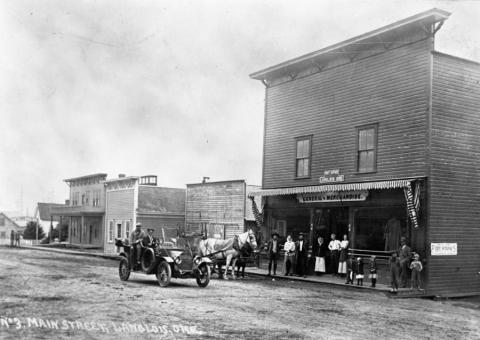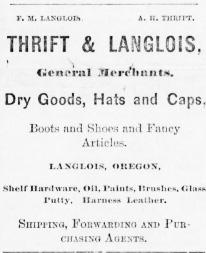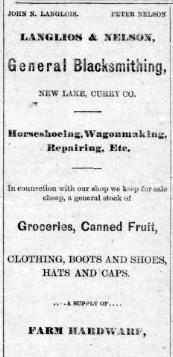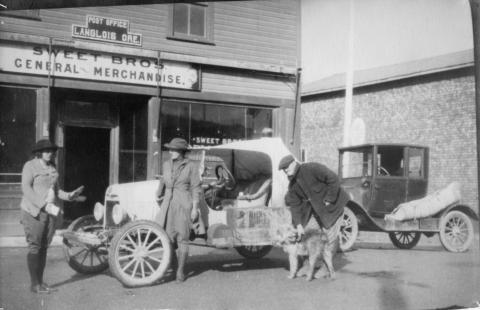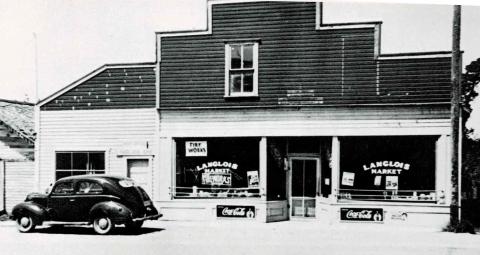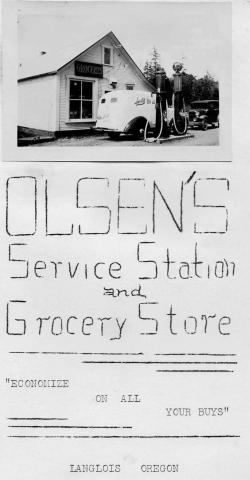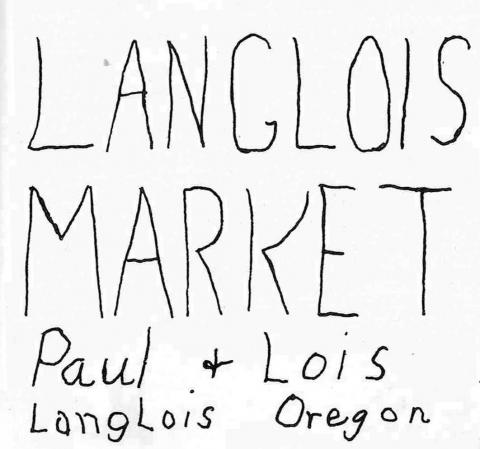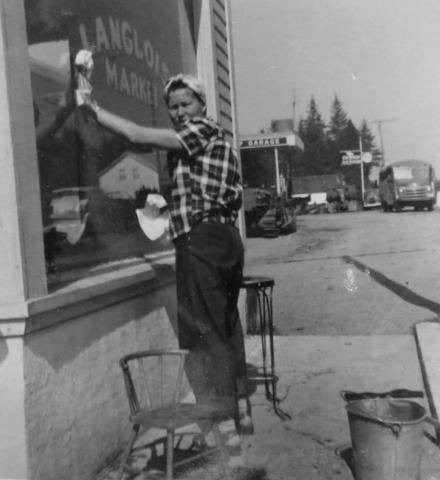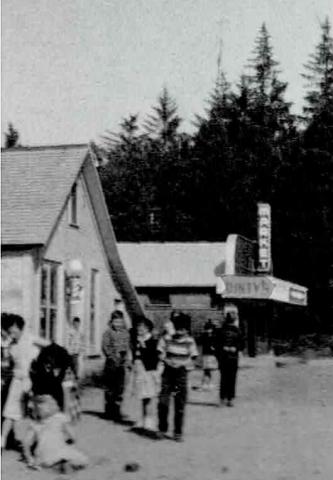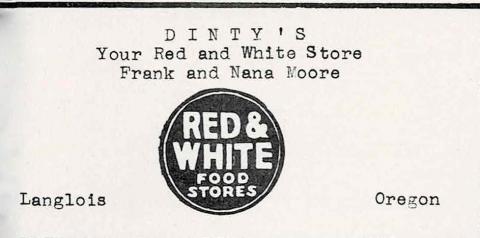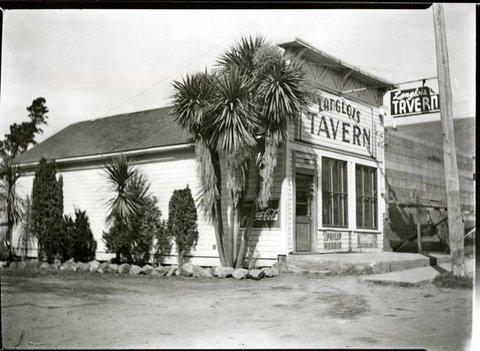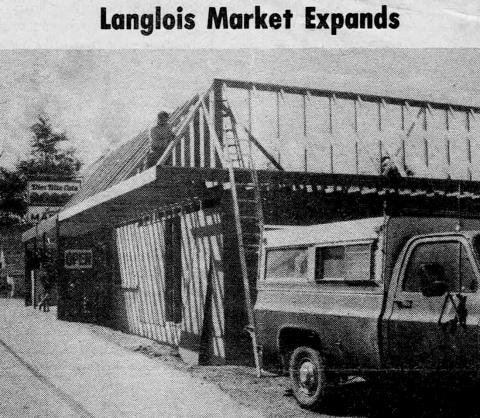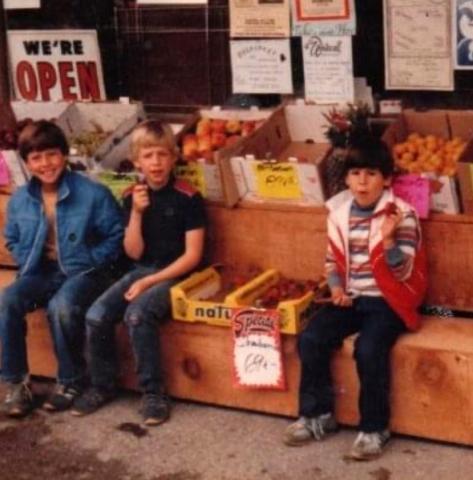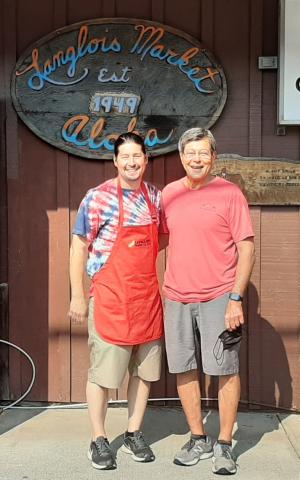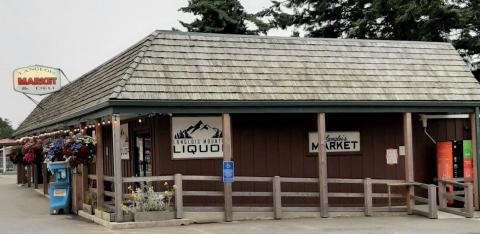A Short History of Langlois, Oregon Grocers by Bonnie Jensen Cox
In 1854 and succeeding years, William V. Langlois filed land claims and purchased property north of Floras Creek, creating an amalgam of acreage for a family farm. (ref 1) William had previously owned a mercantile in Port Orford but desired a home on Floras Creek for his wife and seven children. (ref 2) One of his neighbors was A. H. (Alexander Hamilton) Thrift who shared similar agribusiness goals and had amassed 840 acres on the same fertile plain shored by the Pacific Ocean. Through influence and investment, both families would play an integral role in the upstart of grocers that would feed and supply the clientele of northern Curry County and its peripheral areas.
In 1881 A. H. Thrift and wife Mary donated three tracts of land to develop a town east of their ranch that would be named "Dairyville," but it was not until 1889 that the couple filed a cadastral map with the Curry County clerk. Interestingly, the same year the plat was filed, A. H. Thrift and Frank Langlois placed an ad in the Bandon Recorder referring to their mercantile in "Langlois"---not Dairyville. Precedent to their intown location, Francis "Frank" M. Langlois (third son of William V. and Mary) operated a general store in a building on the family ranch about one mile west of today's town of Langlois. Nearby, Frank's brother James and partner Peter Nelson operated a similar mercantile on the Langlois family's New Lake property.
A. H. Thrift and F. M. Langlois (business partners a generation apart) shared a vested interest in establishing their proposed store on the newborn town's main road. In April of 1881 Frank received a federal appointment that qualified him to become postmaster. (ref 3) Adjacent to the store that the two men financed was the post office--- "Langlois Post Office"--- the name derived from the surname of its postmaster. Though "Dairyville" was the referenced name of the town for three decades, by 1912 the name of the farm village had morphed to "Langlois," and the name "Dairyville" had become a footnote. (ref 4)
In 1899, Thrift and Langlois sold their store to Edward Rackleff who became postmaster for the town in 1901. Rackleff was elected joint representative for Coos and Curry Counties in 1906, and would hire stand-ins to clerk for him during legislative sessions in Salem. In 1910, his store with post office was destroyed by fire along with much of the town's west-side business district. Edgar Thrift (son of A. H. and Mary Thrift) bought the salvaged stock from Rackleff and rebuilt the store on the same site, officially re-opening it in 1912. Like Frank Langlois and Ed Rackleff before him, Edgar Thrift became the town's postmaster, a position he held for nearly a decade.
In 1918, the Sweet brothers (W. J. and Arthur, sons of Nova Scotia immigrants John and Susan Sweet) bought the Langlois general store with post office from Edgar Thrift. Eventually, a third brother, Alfred J. (aka "Sally") would join them in their enterprise. Arthur Sweet served as postmaster for several years and Al Sweet was designated "acting postmaster." (ref 5) Al was petite in stature and remembered as a gregarious merchant with an "easy smile." Annabelle (Strain) Haga remembers the first-of-the-month trips to the grocery store with her father and sisters, their mission to pay the family’s grocery bill. She waited patiently, knowing that after business had been transacted Mr. Sweet would treat each child to a piece of candy.
Down the street from Sweets' enterprise was competition from Walter and Mollie Hood whose store with meats and groceries was housed on the ground floor of the former W.O.W. (Woodmen of the World) building, the upstairs utilized for living quarters. Though the Hoods advertised the business they had established in 1936 as a "thriving grocery and meat market," by the end of 1941 the couple had suspended operations. In 1942, Arthur and Marguerite Blanche Kane purchased the W.O.W. hall and continued the grocery for a while, but by 1947 they had phased it into a dry goods store. Because of the Kanes' proprietorship, many Langlois residents refer to the "W.O.W. building" as the "Kane building." In 2021 the building is the business place for Rain Coast Arts owned by Carol Waxham and Thomas Medlin.
Also putting the squeeze on A. J. Sweet's mercantile was competition one block north where Andrew "Ole" Olsen had a small grocery fronted with "visible" Signal gas pumps that he established circa 1917. A few years later, Johnny and Ruby James operated Olsen's tiny grocery as well as an auto repair garage next door---- the precursor to Aldropp's Garage that started in 1932. (ref 6)
Throughout its history, Olsen's mini mart seemed caught up in a continuous cycle of revolving ownership. Between 1917 and 1948, the store sequentially went from original owner Andrew Olsen to Les Hutton (who ranched on Willow Creek); to Johnny and Ruby James in 1929; back to Olsen in 1938; then on to Vera and Charles Chesley (who ranched in the Langlois hills); and finally to Frank Moore in 1948. With Aldropps pumping gas next door, plus Richfield pumps in front of Cheever Hardware and pumps at Denmark Store three miles south, the gasoline market was saturated and the visible pumps in front of Olsen's mini-mart removed. (ref 7)
In 1946, Al Sweet (by then apparently sole owner of the business that carried his name) sold the store and inventory to Lois and Paul Smith. Lois, formerly a school teacher at Prosper northeast of Bandon, was appointed the town's first female postmaster in 1943, a position she held for 34 years. The Smiths named their mercantile, "Langlois Market," and when they sold the business and leased the building to Ray and Ethel Boston in May of 1951, the name continued. Two weeks following transfer of ownership from Smiths to Bostons, both the store and post office accessible from inside the store were robbed, the looter(s) gaining entrance by forcing the building's rear door then lifting merchandise and burgling the postal safe. In 1955, Ray Boston was hired to build a new free-standing facility for the post office at 2nd and Jackson.
Ray and Ethel operated Langlois Market for twenty years. Son Lanny remembers his mother as an astute, industrious business woman. Ethel was solicitous in her display of merchandise, staging chilled sodas and beer immediately right of the store's main entrance, magazines and comic books to the left. (ref 8) To find meats, produce, and dairy the customer needed to walk from the front of the store toward the rear----thus assuring that the shopper would have opportunity to survey the store's inventory. Many former shoppers remember the heavily oiled dark fir floors pocked and punctured by the caulked boots of loggers and mill workers.
Some of the meats displayed were purchased wholesale in halves or quarters, then cut or ground by Ethel or Ray for retail. Lanny (later Bandon's fire chief) helped tally the accounts receivable when he was old enough, and reconciled the till at day's end. He also kept the beverage machines stocked.
The Bostons lived behind and above the store. Ray, a carpenter by trade, used his multiple building skills to convert a portion of a warehouse attached to the store's west side into a comfortable apartment. Upstairs sleeping quarters were divided from an additional stock storage area. Like all residents in the community their phone number was short---181
In the 1950's, Bostons' Langlois Market was in competition with Dinty's on the north end of town. Its owners, Frank Moore (a retired civil engineer) and wife Nana first housed their little market in Andrew Olsen's vacated grocery while Frank and his brother Leslie built a new store next door---the building that houses today's Langlois Market. Signage displayed on the store's front attests to its date of origin: "Established in 1949". (ref 9)
Dinty's Red and White (part of a franchise of small grocery stores) had a grand opening in its new quarters in May of 1950. Entrance to the store sat within thirty feet of Highway 101, the county's main thoroughfare. In 1952 a near calamity occurred when a trailer being towed by a car driven by a local resident became detached from its hitch and careened through the front plate glass windows. There were no personal injuries, but there was substantial damage to the store.
In 1956 the Moores sold their store, then one year later they "repurchased" it and once again became sole owners. In March of 1960, Bostons bought Dinty's Red and White from the retiring Moores and supplanted it with "Langlois Market," thus vacating the Smith's building.
In 1966 a fire gutted the unoccupied building that had once housed Ethel and Ray's first market on the block's northeast corner. Adjacent to it was a café, and on the southeast end of the block was a tavern. Immediately south of that was the Cheever Building where Lute and Larue Henry offered general merchandise, sporting goods, and automotive repairs. Ethel Boston first noticed the early-morning flames visible from her kitchen window, their dwelling now a large house located behind their new Langlois Market site. She hurriedly phoned Archie Aldropp who manned the town's fire truck then contacted business owners until a burned telephone pole collapsed the town's phone service. It was only through the resourceful use of a hose connected to the Langlois Water System that Carl Evans (shielded by a sheet of plywood) watered down and saved the Cheever building while Lute and Larue Henry and various good Samaritans frantically extracted essential business papers and inventory from their threatened livelihood. Because of those communal efforts, the building still stands in 2021. The Cheever Building is basically a storage facility today, but the attached annex that Lute Henry added in 1946 to service autos and the farm machinery he sold now contains the Floras Creek Coffee Company.
After Bostons twenty-year run, the next owners of Langlois Market were Rod and Sandi Sabin who purchased the business in 1971. Rod and Sandi ranched and were raising three little boys during their period of ownership. Sabins sold the business to Sandi's parents, Evelyn (nee DeHaven) and John Bjerg in 1975. Evelyn and John also ranched, and John trucked for Tucker Sawmill. In November of 1978, the Bjergs sold the business to Sue (Sweet) and Lee (Leland) Pestana. Sue and Lee had been school teachers in Hawaii before moving on to Fort Worth where Lee coached basketball at Texas Christian University and worked for an oil company. When the Pestanas decided to leave Texas they considered their options: Return to the big island of Hawaii where they had been offered teaching positions, or move to Langlois where Lee's father-in-law, Piercy Sweet, had heard by word of mouth that the Bjergs were interested in selling the market.
It was under Pestanas' ownership that the original store was first expanded, the parking lot paved, and the deli started. In 1981 the Pestanas hired Langlois carpenter Art Sypher and assistant John Unican to essentially double the building's square footage. Lumber for that project was purchased from Dick and Kitty Tucker's sawmill where their fifteen-man crew specialized in cutting Port Orford cedar and Douglas fir that shipped to worldwide markets.
Perhaps the birth of the store's deli was a case of the tail wagging the dawg. It had been the practice of previous owners to buy readymade sandwiches from a traveling vendor so that a lunch could quickly be had for local workers, primarily from Tucker Sawmill. When the sandwich supplier announced he was retiring his route, Muriel Sweet (mother of Sue and mother-in-law to Lee) suggested the couple sell high end hotdogs accessorized with her homemade mustard sauce, "Everyone likes my mustard recipe," she assured them. The hotdogs were an immediate success and as of 2021 the little market had sold well over a million dawgs, some days serving in excess of 400.
With time the deli menu was expanded to include designer sandwiches christened with names like the Higgins, Cransan, Hammer, and the McLeland, appropriately named for store owner Leland Pestana. When Lee Pestana and Sue Sweet's son, Jacob, assumed ownership of the business in 2012, his top priorities were expansion of the parking lot and a second till for handling the swelling noontime traffic.
In 2019, Jacob applied for a liquor license and hired his childhood friend Joel Deets to build a liquor store annex on the north side of the building. Lumber for the project was purchased from another Langlois childhood friend of Jacob, Uli Lau, CEO of "Oregon Overseas Lumber Company" located south of Bandon. Today, the market thrives. Jacob Pestana is also owner of "The Spoon," a restaurant that ironically sits on the site of the original Langlois Market.
And so from grassroots sowed and cultivated for more than 140 years, the "village" of Langlois, containing approximately 130 citizens in 2021, takes pride in its flourishing Langlois Market worthy of world famous recognition.

